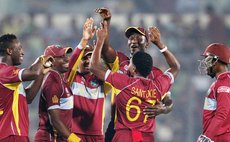The ICC World Cup as it is panning out
The 2015 I.C.C World Cup pans out rather interestingly. There are a number of qualitative groupings within the general assemblage. Take Pool 'B" in which the West Indies are located. The uppermost tier comprises India and South Africa. Next West Indies, Pakistan and Zimbabwe occupy the middle ring, while Ireland and the United Arab Emirates form the base of the pyramid. This is so despite the anomaly of Ireland having edged out West Indies – a lightning strike not likely to stand foreseeable repetition. Much of what happens between moderate strength sides and the lower ranked ones can be attributable to pressures caused by the sometimes unsettling effect of expectation teams place on themselves. The underdog has nothing to lose and often looms as a booby trap causing embarrassing trips or pitfalls for the unwary.
I have every reason to believe West Indies would defeat Ireland nineteen out of twenty times, particularly if World Cup honours are not at state. Let's look at how Ireland fared against South Africa on Tuesday 3rd March at Canberra. The Springboks won the toss and batted first, with every determination to take the life out of their opponents. Hashim Amla benefitted from an early life and entrenched himself to the comfort of 159 bashed in 128 balls in company with Du Plessis getting 109 in a big partnership. The severity of this impacted to a monumental 411 for four churned out at 8.22 runs per over. Ireland was not expected to respond powerfully and succumbed for 210 after early collapse to 48 for 5.
One can hear the obvious rejoinder that West Indies had proved worse themselves when they were flattened with 408 for 5 by South Africa and then suffocating for 151 all out in 34 overs. Truth of the matter – if allowances are admissible for such lapses – West Indies had themselves to blame for two things. They spilled an inordinate number of catches and showed a lack of mental toughness in bowling to the rampant De Villiers plundering 162 from only 66 deliveries and causing his team's total to about double in the last 15 overs. Incidentally, the same De Villiers had scored similarly in winning 4-1 against West Indies in South Africa, which tour was ostensibly a dress rehearsal for the World Cup.
Clearly, the failure of a capacity to learn has very starkly been illustrated by the West Indies bowlers. Our bowling was all over the place, and invariably in areas forbidden by good sense. Ireland, despite the forewarning issuing from the West Indies mishap received the same chastisement – without the bombshell explosiveness of De Villiers.
Poor consolation for West Indies, is the fact that South Africa looms against the Emirates as likely to post what would be another 400, their third in the World Cup this time around and would make a fourth such in the history of the tournament.
India and South Africa stand worlds apart from the rest of Pool "B". Their batting, bowling and fielding afford them enormous advantage. Inclusion of South Africa in a bracket with the Indians is admissible despite the scoreline revealed in the encounter between the two teams. India 307 for 7 and South Africa 177, India winning by 130 runs. Astute observers would not be foolhardy to place odds on India repeating a similar outcome if the two were to clash in a further round of the tournament.
As it stood on Tuesday the West Indies seemed likely to suffer the straight jacket position of equal points with Pakistan, Zimbabwe and Ireland – all at the mercy of a net run rate decider.
Co-hosts New Zealand made their front running position more secure by edging out Australia in a cliff-hanger. Australia 151 in 33 overs, New Zealand 152 for 9 in 24 overs. All told, the match was over in 57 overs as the ball dominated at Eden Park in Auckland. All the same, Australia is about certain to go to the quarter-finals with New Zealand along with Sri Lanka (peaking at the right time). Sad story in this group is England – so lowly placed that scraping out of their predicament can only evolve by a very strong performance against Bangladesh as a very last resort.
The tournament has revealed a strong devaluing of the once prestigious target of 300 runs in 50 overs. All teams, with exception of a bare few, have shown an ability to breeze past that figure when once wickets are in hand in the second half of a run chase. Safest prospect is to bat first and register upwards of 350 followed by astute defending of that target. England with 309 for 6 found that highly insufficient as Sri Lanka zipped to 312 for one – centred on a 212 run partnership involving centuries by Thiremanne 139 not out and Sangakara 117 not out on the Wellington pitch.
At latest call before press time, Australia loosened their holsters and gave another sharpshooting demonstration against Afghanistan who suffered to the extent of 417 for 6, the new world record and World Cup record. It was David Warner's stomping ground as he plundered 178 of 133 balls and Maxwell 88 off only 30 deliveries while Steve Smith got 95 in relatively sedate 103 balls.
Of course, the Afghans, by no means shell-shocked, were, however, too badly outgunned to make significant reply. They fell for 147 in 38 overs. So much for the really bigger guns, except then for Pakistan, seeking to boost their net run rate at expense of the United Arab Emirates by scoring 339 at Napier. But they could not sufficiently limit their opponents to catch up on West Indies on run rate. Emirates scored as many as 210 for 8 and all's left to how well Pakistan might do in their upcoming encounter against South Africa who are more highly fancied. West Indies have India and Emirates in their sights. The one a daunting prospect, the other hopefully a means of making hay while the sun shines.




